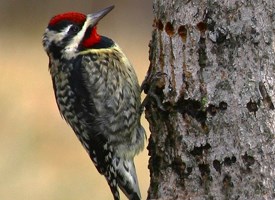Recently I’ve been reading about sapsuckers and — given their feeding habits — this naturally got me to thinking about HOLES. Children’s books about holes (and digging them) have long had appeal. And there have been some great ones.
Ruth Krauss nailed it with the line “a hole is to dig”: holes, like so many things kids make when they play (block buildings, fairy houses, etc.) are totally transient. In addition, they are completely immaterial (a hole is made of nothing, really, but space or air). If you spend all this time making something that won’t last, and that thing is really, essentially nothing, then it stands to reason that the joy of it is less in the product than in the process itself: digging or poking or even pecking.
Books with pages that actually have holes have great appeal too. And why not? What little kid doesn’t like to stick her fingers into them? The first book with holes that always comes to mind for me is Eric Carle’s The Very Hungry Caterpillar. It sports plenty of holes — 20 of them by my count — all the same size and running at the exact same latitude on every page where they appear.
Carle’s holes are left by a hungry caterpillar eating his way through everything and anything, and there is actually something oddly comforting about their consistency and regularity and singularity of purpose.
Simms Taback’s Joseph Had A Little Overcoat, proffers crafted and ever-shrinking holes that move around the pages and track the transformations of an ever-useful (and ever-shrinking) piece of fabric. Like Carle’s, they work beautifully from both sides of the page. (Taback’s version of There Was An Old Lady Who Swallowed A Fly uses expanding holes nicely too.)
In Oyvind Torseter’s more recent The Hole, a hole appears in the same spot on every page — as if someone ran a drill through the center of the book. I really wanted to love this book but it didn’t happen for me: while the hole never moves, the narrative twists and turns around it in ways I couldn’t keep a grip on.
There seem to be a number of board books that offer the toddler set holes too — like the Funny Finger Board Books (by Mark Shulman, illus. by Jenny Harris). The finger-sized holes in these books — and others — lets kids turn their digits into all manner of goofy, wiggly appendages.
It shouldn’t have surprised me to learn (here) that Herve Tullet, master of the interactive book and devotee of toying with notions of book-as-object, has played with the idea a lot — in The Book With A Hole, The Game of Finger Worms, The Game of Lets Go, and The Finger Circus Game..
I managed to get my hands on a copy of The Book With A Hole. More an exploration of what a hole might be than a narrative like The Very Hungry Caterpillar or Joseph Had A Little Overcoat, The Book With a Hole is a sort of graphic list. Tullet’s clever illustrations lay out numerous possibilities for paper holes and the things you can do with them:
- you can put things in them (fingers, faces, hands and feet are especially fun!)
- you can pull things out of them
- you can look through them
- you can imagine what’s in them
- you can jump into them
- you can jump over them
- you can circumnavigate their edges
- you can toss things into them
- you can string things through them
- you can use them to focus your attention
- you can live in them!
- and you can sit, and wait, and watch what emerges from them
All these propositions are rife with opportunities and ideas for more books with holes. And why not? Holes are empty vessels — containers of nothing just waiting to be filled. Which means they are full of possibilities.
Back to my sapsuckers though: the neat rows of holes they peck into the bark of trees initially give the birds access to sap. Once the sap oozes out and starts to get sticky, other insects show up to feed too, and get stuck, and so become but another, more protein-rich sapsucker meal.
Which means that holes can also be:
- magnets, or
- traps, or
- feeding spots
The possibilities really are endless…






